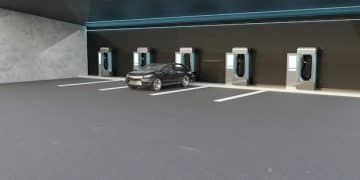Used Electric Vehicle Market Growth: Key Factors in the US

The growth of the used electric vehicle (EV) market in the US is primarily driven by increasing affordability, growing environmental awareness, government incentives, expanding charging infrastructure, and improvements in battery technology that enhance vehicle range and longevity.
Interested in the eco-friendly and economical advantages of electric vehicles but hesitant about the price tag of a new one? The used EV market in the US is rapidly expanding, offering a sweet spot for consumers. Let’s explore what are the key factors driving the growth of the used electric vehicle market in the US.
Understanding the Used Electric Vehicle Market Dynamics
The used electric vehicle (EV) market is gaining momentum in the United States, presenting a unique landscape compared to traditional gasoline-powered cars. Several factors are converging to fuel this growth, making used EVs an increasingly attractive option for budget-conscious and environmentally aware consumers.
This market’s dynamics are influenced by a combination of economic, environmental, and technological factors. Understanding these dynamics is crucial for both buyers and sellers looking to navigate the used EV market effectively. Let’s delve into these dynamics further.
Price Depreciation and Affordability
One of the primary drivers of the used EV market is price depreciation. New EVs, like all new cars, experience significant depreciation in their first few years. This depreciation makes used EVs much more affordable for a broader range of consumers.
Compared to gasoline cars, EVs sometimes depreciate more quickly due to factors like rapid technological advancements and government incentives that favor new EV purchases. This creates opportunities for buyers to acquire relatively recent EV models at substantially lower prices.
Environmental Consciousness
Increasing environmental awareness is another significant contributor to the growing popularity of used EVs. Consumers concerned about climate change and air pollution are increasingly seeking greener transportation options.
Used EVs offer a way to reduce one’s carbon footprint without the financial burden of buying a new EV. By extending the life cycle of existing EVs, consumers contribute to a more sustainable automotive ecosystem.

Government Incentives and Policies Impacting Used EVs
Government incentives and policies play a pivotal role in shaping the used EV market. While many incentives are geared towards new EV purchases, some policies indirectly benefit the used market.
These incentives can include tax credits, rebates, and subsidies, which can reduce the overall cost of ownership for both new and used EVs. Understanding these policies is essential for both buyers and sellers.
Federal and State Tax Credits
While federal tax credits primarily target new EV purchases, some states offer incentives for used EV buyers. These state-level incentives can significantly reduce the upfront cost of a used EV, making them more attractive to consumers.
Additionally, some states offer rebates or tax credits for installing home charging stations, further incentivizing EV adoption. Buyers should research available incentives in their state for maximum savings.
Regulatory Policies and Emission Standards
Stringent emission standards in many states are also contributing to the demand for EVs, both new and used. As states aim to reduce greenhouse gas emissions, EVs become an increasingly attractive option for compliance.
Policies like California’s Zero-Emission Vehicle (ZEV) mandate encourage automakers to produce and sell more EVs, increasing the supply of used EVs in the market over time.
Technological Advancements and Battery Health
The evolution of battery technology is a critical factor influencing the used EV market. Improvements in battery range, lifespan, and charging times have alleviated many concerns associated with EV ownership.
Battery health is a primary concern for used EV buyers, but advancements in battery management systems and warranty programs have helped to mitigate these concerns. Understanding battery-related factors is vital for informed decision-making.
- Battery Range: Newer EV models boast significantly longer battery ranges than older models, making them more appealing to buyers.
- Battery Lifespan: Improved battery chemistry and thermal management systems have extended the lifespan of EV batteries.
- Charging Times: Faster charging technologies have reduced the inconvenience of charging, making EVs more practical for daily use.
Battery Degradation and Warranty Programs
Battery degradation is a natural process that affects all EV batteries over time. However, advancements in battery technology have significantly reduced the rate of degradation.
Many EV manufacturers offer comprehensive battery warranty programs that provide coverage for a specific period or mileage. These warranties can provide peace of mind for used EV buyers concerned about battery health.
Software Updates and Vehicle Performance
Software updates play a crucial role in maintaining and improving the performance of EVs. These updates can enhance battery management, optimize energy consumption, and improve overall vehicle efficiency.
Used EV buyers should inquire about the availability of software updates for the model they are considering. Regular updates can help extend the lifespan and improve the performance of a used EV.

Infrastructure Development and Charging Availability
The expansion of charging infrastructure is essential for supporting the growth of the used EV market. The availability of convenient and reliable charging options is a key factor influencing consumer adoption.
Investments in public charging networks and the increasing availability of home charging solutions have made EV ownership more practical and convenient. Overcoming charging-related anxieties is crucial for market growth.
Public Charging Networks
The growth of public charging networks is critical for supporting EV adoption, particularly for those who lack access to home charging. Companies like Tesla, Electrify America, and ChargePoint are expanding their charging networks across the US.
These networks offer a variety of charging options, including Level 2 chargers and DC fast chargers. The availability of fast charging options can significantly reduce charging times, making EVs more practical for long trips.
Home Charging Solutions
Home charging is the most convenient and cost-effective way to charge an EV. Many EV owners install Level 2 chargers in their homes, which can provide a full charge overnight.
Government incentives and utility programs often offer rebates or discounts for installing home charging stations. Home charging makes EV ownership more convenient and reduces reliance on public charging networks.
Consumer Perception and Awareness
Consumer perception and awareness play a significant role in shaping the used EV market. Increased awareness of the benefits of EVs, coupled with positive consumer experiences, can drive demand.
Addressing common misconceptions about EVs, such as range anxiety and battery life concerns, is essential for fostering trust and confidence in the used EV market. Educating consumers about the benefits of EVs is crucial for driving adoption.
Addressing Range Anxiety
Range anxiety, the fear of running out of battery power, is a common concern among potential EV buyers. However, advancements in battery technology and the expansion of charging infrastructure have helped to alleviate this concern.
Educating consumers about the actual range of EVs and the availability of charging options can help to overcome range anxiety. Providing real-world data and testimonials can also build confidence in EV ownership.
Building Trust and Confidence
Building trust and confidence in the used EV market requires transparency and reliable information. Independent battery testing and vehicle history reports can provide valuable insights for buyers.
Third-party certifications and warranties can also help to instill confidence in used EV purchases. Establishing clear standards and guidelines for used EV sales can foster a more transparent and trustworthy market.
Economic Factors and Market Trends
Economic factors and market trends also influence the growth of the used EV market. Factors like fuel prices, government policies, and consumer preferences can all impact demand.
Monitoring these economic factors and market trends is essential for understanding the current state and future prospects of the used EV market. These trends can provide insights into consumer behavior and market dynamics.
- Fuel Prices: Rising fuel prices make EVs more attractive to consumers seeking to reduce their transportation costs.
- Government Policies: Supportive government policies, like tax credits and emission standards, can drive EV adoption and increase the supply of used EVs.
- Consumer Preferences: Shifting consumer preferences towards more sustainable transportation options can increase demand for used EVs.
Supply Chain Dynamics
The supply chain for EVs, including batteries and other components, can also impact the used EV market. Disruptions in the supply chain can affect the availability and pricing of new EVs, which can, in turn, impact the used market.
Monitoring supply chain dynamics is essential for understanding potential challenges and opportunities in the used EV market. Diversifying supply chains and investing in domestic production can help to mitigate risks.
Future Outlook
The used EV market is poised for continued growth in the coming years. As more EVs enter the market and battery technology continues to improve, used EVs will become an even more attractive option for consumers.
Continued investments in charging infrastructure and supportive government policies will also play a crucial role in driving growth. The future of the used EV market looks bright, with opportunities for both buyers and sellers.
| Key Factor | Brief Description |
|---|---|
| 💰 Affordability | Depreciation makes used EVs cheaper. |
| 🌍 Environmental Awareness | Eco-conscious consumers seek green options. |
| 🔌 Charging Infrastructure | More charging stations ease EV use. |
| 🔋 Battery Tech | Better batteries improve EV appeal. |
FAQ
▼
The primary reason is the increased affordability. New EVs depreciate quickly, making their used counterparts accessible to a broader range of buyers.
▼
While federal incentives mainly target new EVs, some states offer incentives for used EV purchases. Check your local regulations for details.
▼
Battery health is crucial. Degradation reduces range and performance, directly affecting the vehicle’s market value. Warranties can help mitigate risks.
▼
A robust charging network is vital. The more accessible and reliable charging options are, the more appealing used EVs become to potential buyers.
▼
Range anxiety is lessening due to better batteries and increased charging stations. However, addressing consumer concerns through education remains important.
Conclusion
In summary, the used EV market’s growth is fueled by affordability, environmental concerns, government incentives, technological advancements, and infrastructure development. As these factors continue to evolve, the used EV market will likely expand, offering sustainable and economical transportation options to more consumers.





